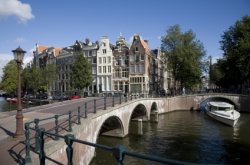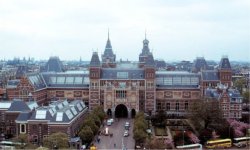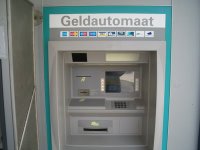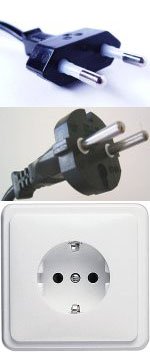Amsterdam Guide - Basic Amsterdam City Guide And Tourist Attractions
This Amsterdam Guide provides you with some basic Amsterdam tourist information.
What are the top attractions, best cafes, best way to get around, and what about ATMs and mobile phones? How to get to Amsterdam quickly and without going broke?
If you're missing any tourist attractions in this Amsterdam city guide, please let us know so we may add it.
Attractions
The leading Amsterdam tourist attraction is the city itself, with its 165 canals and magnificent architecture starting from the 13th century. During the 1650-1750 period, Amsterdam was the richest trading city in the world and this shows.

Explore the city through canal cruises, city walks or the local way: by (rental) bike. We also recommend visiting a few of Amsterdam's fine art and history museums (see below) that paint a colorful picture of Amsterdam's past.
There are more bars and cafes in Amsterdam than any Amsterdam guide could ever list (over 1000). You'll clearly recognize 3 types of cafes in Amsterdam: the folksy brown cafes, the hip designer cafes and the classical Grand Cafes. See our Amsterdam cafes page for some of the nicest. In our Amsterdam pub guide we listed some top choices that come closest to what a Briton calls a pub. Amsterdam has a killer nightlife too, with a diverse and hip club scene.
Amsterdam is also famous for it's liberal drugs and prostitution policies. Many visitors take a look in Amsterdam's unique Red Light District. Window prostitution is there for everybody to see. Likewise, Amsterdam coffee shops draw many foreign visitors, too. Anybody can buy small quantities of weed and hash here. They are part of the Dutch 'allow it so you can regulate and control it' attitude, also refered to by some Amsterdam city guides as the 'controlled sleaze approach'.
Here's more about Amsterdam attractions and things to do in Amsterdam.
Museums

The Rijksmuseum in Amsterdam
For first-time visitors, this Amsterdam guide certainly recommends the Rijksmuseum (the national museum that specializes in 17th century 'Dutch Masters': oil paintings by Rembrandt, Vermeer etc.).
Also highly popular are the Van Gogh Museum (specializing in Dutch painter Vincent van Gogh and contemporaries) and the Anne Frank House (the former hiding house of this famous Jewish girl during the Second World War).
Off the beaten path, you will find Ons' Lieve Heer Op Solder (Our Lord In The Attic), a secret Catholic church from the 17th century that's now a museum, and the Oude Kerk (Old Chuch), the oldest building in Amsterdam dating back to 1250. And of course, there are various sex and hash museums in Amsterdam as well. See our list of recommended Amsterdam museums and our list of all museums in Amsterdam worth mentioning.
Here's more about high brow Amsterdam culture.
Getting There
Amsterdam Schiphol Airport (AMS), Amsterdam's only, is a major European hub with hundreds of airliners going there, so you should have no problems finding a good, cheap flight. See our tips elsewhere in this Amsterdam guide for getting cheap flights to Amsterdam, our overview of airlines to check for cheap tickets to Amsterdam and our page how flights to Amsterdam from various part of the globe work. See our train travel page on the good railway connections to Amsterdam. You can of course come by car to Amsterdam, but in large parts of the city, parking is limited and expensive (up to 4 euros per hour).
Nationals from (among others) the following countries don't need a visa: USA, UK, Canada, all EU en EEA countries, and Switzerland. More information is here: www.government.nl/topics/visa-for-the-netherlands-and-the-caribbean-parts-of-the-kingdom.
Getting Around
This Amsterdam guide advises you to do like the Dutch and rent a bike. It costs around 10 euros a day with discounts for extensions, e.g. at MacBike at the Central Station. The city centre (where all the sights are) is small and you'll get around quickly. It's the authentic Amsterdam experience!
The other best way is Amsterdam's cheap and efficient public transportation: especially trams and the subway. The blue and pink paper tickets (strippenkaarten) have now been fully replaced by PT smart cards (OV chipkaart). So unless you have the I Amsterdam card (which gives you free access to trams, buses and the subway for 24, 48 or 72 hours, next to free access to museums etc.), you need to buy a PT smart card.
When entering ("checking in") a tram, bus or subway, you have to hold your smart card against the reader until you hear a beep. Don't forget to "check out" in the same way when leaving the tram/bus/subway, or it will cost you much more.
If you are staying for a few days, you can best buy a disposable smart card. They are pre-charged and give access to trams, buses and the subway for time slots of 1 hour, 2x1 hour, 24 hours, 48 hours or further time slots up to 168 hours (e.g. a full 24/7 week). If the credit is used up, throw them away. Buy disposable smart cards at GVB ticket offices on all the Amsterdam train stations, or from the vending machines on Amsterdam subway stations. The vending machines accept euro coins and Dutch bank cards, but often no credit cards. Disposable smart cards for 1 hour are also for sale inside trams and buses (but not inside the subway).
If you're staying for a longer period of time, then you can also buy an anonymous smart card for 7,50 on Dutch train stations. There is no credit on them, so you need to charge it at the vending machines which are in all Amsterdam train and subway stations, as well as in some Albert Heijn and Primera shops.
When To Go
Amsterdam is really an all-year-round destination. But the most pleasant months are the summer months when the weather is warm, the trees lining the canals are green and most events take place. However, mid June to mid August is also the tourist high season and the city is crammed with foreigners then.
So this Amsterdam guide likes to think that perhaps the perfect time to go is roughly between the end of April to the end of May, and mid August to the end of September. The city is relatively quiet then but the weather is still good.
Language
The official language is Dutch, but virtually all Amsterdammers speak English (and they're proud of it!), and more often than not some German and/or French too. But if you'd like to know a few words of Dutch to impress the locals: yes is 'ja' (yah), no is 'nee' (nay), hello is 'hallo' (hal-LO), thank you is 'bedankt' (b'-DUNKED'), please is 'alsjeblieft' (as-yu-BLEEFT). The single 'a' is pronounced as in 'bar'.
Money

Your Amsterdam guide continues with the money. Like many other European countries, the currency is the euro. The easiest ways to get euros is to get them from an ATM ("geldautomaat"), which are everywhere in Amsterdam. Most ATMs work with credit cards of the Visa and MasterCard type, and debit cards that use the Maestro or Cirrus systems.
Changing cash money is best done at a GWK branch (at the airport or Amsterdam Central Station) or bank branches of e.g. ABN Amro, Rabobank, ING, etcetera. Many hotels also change, but charge more.
While credit cards (usually MasterCard and Visa) are accepted in most hotels and restaurants, many shops, cafes or museums still don't.
Tipping in Amsterdam is not really expected nor necessary, but adding some 5% to your bill in cafes, bars, restaurants and taxis is appreciated in case of good service.
Time Zone
Amsterdam is in Central European Time (CET), the same as in Western and Central Europa (minus the UK). This is 1 hour later than London, 6 hours later than New York and 10 hours later than Los Angeles.
In the high summer, sunrise is around 5.30am and sunset is around 10pm, but the sky is still light until around 11pm. In the high winter, sunrise is around 8.30am and sunset around 4.30pm.
Go here for the current time in Amsterdam.
Safety And Health
Amsterdam is one of the safest European capitals. However, as any Amsterdam guide should tell you, stealing bikes is still a kind of local sports. One out of ten bikes is stolen each year, even the old and ugly ones. Every Amsterdammer therefore has a lock twice as expensive as his bike, and you should always attach your lock to bicycle racks, street signs, etc. Furthermore, there are usually some pickpockets at the Central Station, Red Light District and inside crowded trams. Just watch your stuff a bit.
There are no specific health problems, as any Amsterdam guide would agree, and Amsterdam tap water is of good quality.
Mobile Phones
Like the rest of Europe (including the UK & Ireland), Amsterdam has the GSM 900/1800 mobile phone system. Foreign mobile phones that work with this band, will probably automatically switch over as soon as you get off your airplane.
Since the USA and Canada have the GSM 1900 system, many mobile phones from there don't work on the GSM 900/1800 system, unless it's a tri-band or quad-band phone. One option is, buying a cheap phone (without SIM lock) once you arrive in the Netherlands (they start at about 50 euros), and inserting your American / Canadian SIM card. You can also buy a pre-paid phone in Amsterdam, so you will pay the local calling rates.

Electricity
Amsterdam and the Netherlands have the 220-240 Volt / 50Mhz system - the same as elsewhere in Europe, Asia, Australia and Africa.
However, visitors from (among others) the UK, Ireland, Australia, Switzerland and others need to bring a plug adaptor. C, E and F type plugs generally fit on Dutch electricity sockets. Here's a handy tool for checking power plugs in the Netherlands.
The USA, Canada and a large part of South America have the different 110-127 Volt system, which means many devices from there can only be connected in Amsterdam using a transformer.
However, some devices (including mobile phone and camera chargers) may also work without a transformer, but check this carefully in advance.
Are you missing any important information in this Amsterdam guide? Please contact me.
Related Pages:
- A concise Amsterdam city guide
- The basics about local Amsterdam train travel
- International train travel to/from Amsterdam
- Some general interest information about Amsterdam (Netherlands)
- Fun and amazing Amsterdam facts
- What's true about the tulips, wind mills and wooden shoes in Amsterdam and Holland?
- Handy Amsterdam information about transport, visa, money and more...
- Introduction to gay Amsterdam
- Directory of good Amsterdam sites
- Background information on Amsterdam
- Some famous people from Amsterdam
- A short history of Amsterdam
- Tips for cheap travel in Amsterdam
- Where is Amsterdam on the world map?
- High brow Amsterdam culture: things to do
- What are the Amsterdam people like?
- Folk culture in Amsterdam
- Amsterdam architecture from 1700 to present
- Old architecture in Amsterdam (13th-17th centuries)
- Looking for Amsterdam yoga centers?
- Meeting girls , boys and women in Amsterdam
- More interesting facts on Amsterdam
- How to select the best Amsterdam canal cruises
- Where to find a gay sauna in Amsterdam
- Guide to Amsterdam cosmetic surgery
- The Gay Pride Amsterdam: Europe's biggest gay party
- Where to meet the girls of Amsterdam
- How to find jobs in Amsterdam
- The population of Amsterdam is the most international of the world!
- From Amsterdam Guide back to Amsterdam Advisor

 Subscribe To
Subscribe To
